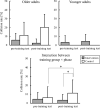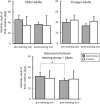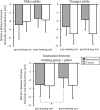Improved Walking Through an Aperture in a Virtual Environment Transfers to a Real Environment: Introduction of Enriched Feedback and Gradual Increase in Task Difficulty
- PMID: 35308597
- PMCID: PMC8931267
- DOI: 10.3389/fspor.2022.844436
Improved Walking Through an Aperture in a Virtual Environment Transfers to a Real Environment: Introduction of Enriched Feedback and Gradual Increase in Task Difficulty
Abstract
Virtual reality (VR) could be used to set up a training protocol to improve one's collision-avoidance behavior. In our previous study, we developed a VR system for training older individuals to walk through an aperture in a manner that is both safe (i.e., no collision) and efficient (i.e., no exaggerated behavior to ensure collision avoidance). In the present study, we made several modifications to the VR system in terms of enriched feedback (vibratory stimulation for virtual collisions and the addition of positive feedback for successful trials) and gradual increase in task difficulty during training to strengthen the skill transfer. Nineteen older adults (74.4 ± 5.3 years of age) and 21 younger adults (25.1 ± 5.0 years of age) participated. They were randomly assigned to one of two training groups: the intervention group (older: n = 10; younger: n = 10) or the control group (older: n = 11; younger: n = 9). The experiment consisted of pre- and post-training tests in a real environment and training in a VR environment. During training, participants held a horizontal bar while stepping in place as if a VR image on the screen were moving in response to their stepping. Participants in the intervention group tried to pass a narrow aperture without collision while attempting to minimize their body rotation to avoid collision as much as possible. The criterion upon which the collision-avoidance behavior was regarded as successful became incrementally more demanding as participants successfully met the previous criterion. Participants in the control group passed through a very wide aperture, so that collision-avoidance behavior was unnecessary. A comparison between pre- and post-training test performances showed that, for both older and younger adults in the intervention group, the spatial margins became significantly smaller, while the success rate remained unchanged. For those in the control group, neither the spatial margin nor the success rate was improved. These results suggest that the three modifications made for the VR system contributed to improvement of the system and helped participants transfer the behavior learned from the VR environment to real walking.
Keywords: motor learning; obstacle avoidance; older adults; stepping in place; virtual reality.
Copyright © 2022 Suda, Fukuhara, Sato and Higuchi.
Conflict of interest statement
The authors declare that the research was conducted in the absence of any commercial or financial relationships that could be construed as a potential conflict of interest.
Figures









References
-
- Cavallo V., Dommes A., Dang N.-T., Vienne F. (2019). A street-crossing simulator for studying and training pedestrians. Transp. Res. F Traffic Psychol. Behav. 61, 217–228. 10.1016/j.trf.2017.04.012 - DOI
LinkOut - more resources
Full Text Sources
Miscellaneous

